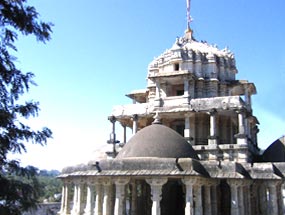Dilwara Jain Temples of India are located near
Mount Abu, a hill station in Rajasthan. Explore Dilwara Jain Temple
of Mt. Abu, India.
Dilwara Temples

Location: Near Mount Abu, Rajasthan
Founded In: 11th to 13th century
Dedicated to: Adinathji, Neminathji, Parshavnathji and Mahaveer
Swamiji
Dilwara Jain temples of India are situated at a distance of
approximately 2.5 km from Mount Abu, the sole hill station in Rajasthan.
One of the most popular pilgrim destinations in the state, these temples
have been found to date back to somewhere between 11th and 13th century.
There are five individual temples inside the Dilwara temple complex of
Mt. Abu. The temples are known for their exquisite use of marble and are
believed to be one of the most magnificent Jain temples not only in
Rajasthan, rather the whole of India.
The gate providing entrance to the temples is splendid in its design.
Dilwara Jain Temples have been enclosed inside high walls and are
situated amidst a range of forested hills. The intricately carved
ceilings, doorways, pillars and panels of the temples add to its beauty
and splendor. The amenities provided at Dilwara Jain Temples include
bathing facilities and provision of guided tours. Each of the five
temples situated inside the temple complex have a unique identity. The
most famous temples at Dilwara are Vimal Vasahi and Luna Vasahi.
Vimal Vasahi (Shri Adinathji Temple)
Vimal Vasahi is the temple dedicated to the first Jain Tirthankara,
Shri Adinathji. The temple dates back to the year 1021 and was
constructed under the patronage of Vimal Shah, a minister of Maharaja
Bhimidev I of Gujarat. Situated in an open courtyard, the temple stands
surrounded by a corridor. The corridor has a number of cells consisting
of smaller idols of the Tirthankaras. The corridors, pillars, arches,
ceilings and 'mandaps' (porticoes) of the temple have been adorned with
beautiful carvings.
The huge hall of Rang Mandap has 12 decorated pillars, carved arches
and a central dome. The pillars have carved images of a female playing
musical instruments, along with 16 Vidhyadevis, goddesses of knowledge.
Nine carved rectangular ceilings make up the Navchowki, while the Gudh
Mandap has a remarkably festooned doorway. It is in this mandap that the
idol of Adinath (a.k.a. Lord Rishabdev) is enshrined. The Hathishala
(elephant cell), built by Prithvipal, houses a row of sculpted
elephants.
Luna Vasahi (Shri Neminathji Temple)
Vastupal and Tejpal, ministers of King Virdhaval of Gujarat, got the
Luna Vashi temple constructed. The temple dates back to the year 1230
and is dedicated to Shri Neminathji, the 22nd Jain Tirthankara. The
ministers got the temple constructed in the memory of their late brother
Luna and took heavy inspiration from the Vimal Vashi temple. The main
hall, or the Rang Mandap, has a central dome that dangles from a
beautifully carved pendent.
The sitting figures of 72 Tirthankaras have been arranged in one
circular band and that of 360 Jain monks in another. There is also a
Hathishala, adorned with 10 beautiful figures of marble elephants. The
Navchowki has some intricate cutting work of marble, while the Gudh
Mandap houses a black marble idol of Neminathji. To the left of the
temple is Kirthi Stambha, a big black stone pillar that was constructed
by Maharana Kumbha of Mewar.
Pittalhar Temple (Shri Rishabhdevji Temple)
Pittalhar Temple is also dedicated to the first Jain Tirthankara,
Adinathji or Rishabhdevji. Bhima Shah, a minister of Sultan Begada of
Ahmedabad is credited with the construction of this temple. Enshrined in
the temple is a huge statue of Rishabhdevji, which is made up of five
metals - the main one being 'Peetal' (brass). The temple comprises of
the main Garbha Griha, the Gudh Mandap and the Navchowki. The Rang
Mandap and the corridor of the temple have been largely left unfinished.
The old idol of Rishabhdevji that was placed in the temple was replaced
and reinstalled in 1468-69.
Khartar Vasahi (Shri Parshvanathji Temple)
Khartar Vasahi is a three-storied structure, constructed by Mandlik and
his family. It dates back to 1458-59 and is dedicated to Lord
Parshvanathji, the 23rd Jain Tirthankara. The tallest of all the Dilwara
temples, Khartar Vasahi has four big mandaps on its ground floor. The
outer walls of the sanctum are adorned with beautiful sculptures,
depicting Dikpals, Vidhyadevis, Yakshinis, Shalabhanjikas and other
ornamental sculptures.
Mahavir Swami (Shri Mahavir Swamiji Temple)
The fifth, and the last, Dilwara Jain Temple is dedicated to Shri
Mahavir Swamiji. It was constructed in the year 1582 and enshrines Lord
Mahaveer, the 24th Jain Tirthankara. The artists of Sirohi beautifully
painted the upper walls of the porch in 1764.


